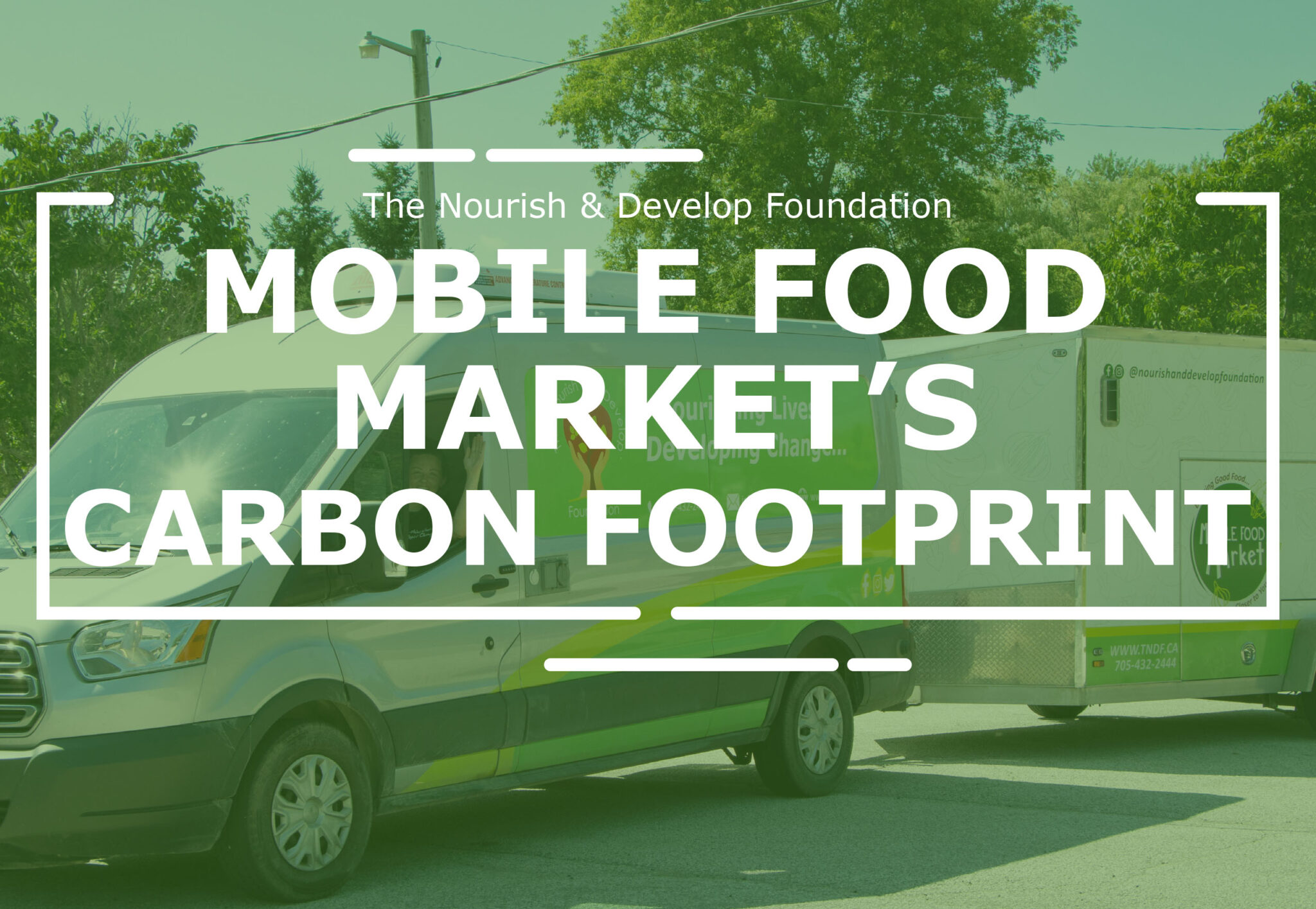Mobile Food Market’s Carbon Footprint
TNDF’s Mobile Food Market (MFM) is an effective way to bring fresh, local produce to various neighbourhoods throughout Brock Township. By bringing our refrigerated van and trailer from town to town, it helps to ensure that everyone has access to affordable, nutritious food options.
But driving our van and trailer comes with an environmental cost – our carbon footprint. A carbon footprint is the total of all the greenhouse gas emissions emitted by a person, business or other organization’s various activities[1]. Greenhouse gases include carbon dioxide (CO2), methane, and nitrous oxide. The excess of greenhouses gases keeps the Earth warmer than it would be without them[2]. Greenhouse gases are the main cause of human-induced climate change[3], and for that reason efforts are made to reduce or offset them.
Climate change directly affects our food systems. By food systems, we mean the production, transportation, trade, storage, processing, packaging, wholesale, retail, consumption, and disposal of food[4]. Climate change and extreme weather, such as high temperatures, droughts, and rising sea levels negatively effect our food quantity and quality of supply[5]. In addition, climate change can limit the availability and access to food and increase prices[6]. While climate change affects our food systems, it’s important to recognize that agricultural, livestock and fishery production in turn affects climate change[7], exacerbating the complexity of the climate change problem.
With TNDF’s mission being to enhance local food security, climate change is an increasingly urgent issue impacting our organization and community.
One of the ways MFM is working to reduce its environmental impact is by purchasing carbon offsets. A carbon offset is “a credit for emission reductions given to one party that can be sold to another party to compensate for its emissions”[8]. Basically, it is financially supporting projects and organizations that are working to reduce or remove carbon from our atmosphere. There are many different types of carbon offset projects. Some of the most common include “renewable energy projects like wind farms, small hydro projects, and biomass projects, along with energy efficiency projects like retrofitting office buildings or introducing more energy-efficient heating technology. Still other projects involve capturing and burning methane from landfills or livestock, preserving forests, and planting trees”[9].
Using a carbon calculator[10], we’ve determined that the MFM drives approximately 566 km per month, and therefore produces approximately 0.12 metric tons of carbon dioxide per month. This represents MFM’s carbon footprint.
Consulting David Suzuki’s Purchasing Carbon Offsets: A Guide for Canadian Consumers, Businesses, and Organizations, MFM has purchased 2 carbon credits from Less.ca to help offset MFM’s environmental impact for 2022. Carbon credits from Less.ca meet The Gold Standard, which was developed by the World Wildlife Fund (WWF) and other organizations to ensure carbon offset credits are audited, valid and reliable. It follows the Clean Development Mechanism (CDM; the model for quality assurance and to quantify greenhouse gas reductions[11]), but adds further requirements, and also limits eligible offset project types to renewable energy and energy efficiency[12]. MFM is pleased to support projects that adhere to the CDM and The Gold Standard.
It’s important to note that purchasing carbon offsets is not in itself the solution. It is a small action within the complex issue of climate change. Other more impactful actions, including but not limited to, reducing, reusing, switching to renewable energies, restoring carbon sinks, meaningful policies, and more, are essential[13]. Carbon offsets is a supplementary action to the larger solutions to climate change.
To learn more about greenhouse gases and carbon offsetting, we suggest visiting David Suzuki’s website, and familiarizing with Purchasing Carbon Offsets: A Guide for Canadian Consumers, Businesses, and Organizations: https://davidsuzuki.org/science-learning-centre-article/purchasing-carbon-offsets-a-guide-for-canadian-consumers-businesses-and-organizations/
If you’re looking to start a conversation with the children in your life, we’d recommend visiting NASA’s website at: https://climatekids.nasa.gov/how-to-help/
[1]Deborah Carlson, Paul Lingl and Rich Wong, Purchasing Carbon Offsets: A Guide for Canadian Consumers, Businesses, and Organizations, (David Suzuki Foundation & Pembina Institute, 2009), 15.
[2] David Chandler, “Explained: Greenhouse Gases”, MIT News Explainer, September 30, 2020, https://climate.mit.edu/explainers/greenhouse-gases
[3] “Cause of Climate Change”, Government of Canada, last modified March 28, 2019, https://www.canada.ca/en/environment-climate-change/services/climate-change/causes.html
[4] Brown, M.E., J.M. Antle, P. Backlund, E.R. Carr, et al., Climate Change, Global Food Security, and the U.S. Food System, 2015, https://www.usda.gov/sites/default/files/documents/FullAssessment.pdf, ix.
[5] Brown, M.E., J.M. Antle, P. Backlund, E.R. Carr, et al., Climate Change, Global Food Security, and the U.S. Food System, 2015, https://www.usda.gov/sites/default/files/documents/FullAssessment.pdf, ix.
[6] Brown, M.E., J.M. Antle, P. Backlund, E.R. Carr, et al., Climate Change, Global Food Security, and the U.S. Food System, 2015, https://www.usda.gov/sites/default/files/documents/FullAssessment.pdf, ix.
[7] Meredith Niles, Jimena Esquivel, Richie Ahuja, Nelson Mango, et al., “Climate Change & Food Systems: Assessing Impacts and Opportunities”, Meridian Institute, November 2017, https://scholarworks.uvm.edu/cgi/viewcontent.cgi?article=1016&context=calsfac
[8] Brown, M.E., J.M. Antle, P. Backlund, E.R. Carr, et al., Climate Change, Global Food Security, and the U.S. Food System, 2015, https://www.usda.gov/sites/default/files/documents/FullAssessment.pdf, ix.
[9] Deborah Carlson, Paul Lingl and Rich Wong, Purchasing Carbon Offsets: A Guide for Canadian Consumers, Businesses, and Organizations, (David Suzuki Foundation & Pembina Institute, 2009), 17-18.
[10] “Carbon Calculator”, Carbon Footprint, https://www.carbonfootprint.com/calculator.aspx
[11] Deborah Carlson, Paul Lingl and Rich Wong, Purchasing Carbon Offsets: A Guide for Canadian Consumers, Businesses, and Organizations, (David Suzuki Foundation & Pembina Institute, 2009), 36
[12] Deborah Carlson, Paul Lingl and Rich Wong, Purchasing Carbon Offsets: A Guide for Canadian Consumers, Businesses, and Organizations, (David Suzuki Foundation & Pembina Institute, 2009), 36.
[13] “Responding to Climate Change”, NASA Global Climate Change: Vital Signs of the Planet, https://climate.nasa.gov/solutions/adaptation-mitigation/



